
by Rick O'Connor | Jan 19, 2018
In the last article, we discussed what phytoplankton are, what their needs were, and their importance to marine life throughout the Gulf and coastal estuaries. In this article, we will discuss the different types of phytoplankton found in our waters.
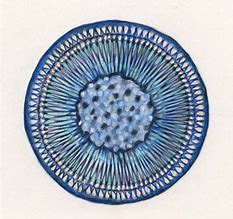
The spherical shape of the centric diatom.
Image: Florida International University
Marine scientists interested in the diversity and abundance of phytoplankton will typically sample using a plankton net. There are a variety of different shapes and sizes of these nets, but the basic design would be funnel shaped with a sample jar attached at the small end of the funnel. The plankton net would be towed behind the research vessel at varying depths for a set period of time. All plankton collected would be analyzed via a microscope. According to the text Identifying Marine Phytoplankton (1997) there are at least 14,000 species of phytoplankton and some suggest as many as 120,000. Most of these, 12,000-100,000, are diatoms, one of five classes of marine phytoplankton. The majority of the phytoplankton fall into one of two class, the diatoms and the dinoflagellates.
Diatoms are typically single celled algae encased in a clear silica shell called a frustule. The frustule can come in a variety of shapes, with or without spines, and many resemble snowflakes – their quite beautiful. They are found in the bay and Gulf in great numbers, as many as 40,000,000 cells / cup of seawater. They are the dominate phytoplankton in colder waters and are most abundant near upwellings. These are the “grasses of the sea” and the base of many marine food webs. When diatoms die, their silica shells sink to the seafloor forming layers of diatomaceous earth, which is used in filters for aquariums and oxygen mask in hospitals.
Dinoflagellates differ from diatoms in that they produce two flagella, small hair-like projections from the algae that are used for generating water currents and movement. Their shells are not silica but layers of membranes and are called thecas. Some membranes are empty and others contain different types of polysaccharides. Dinoflagellates are more abundant than diatoms in warmer waters. There are about 2000 species of them. One type, Noctiluca, are responsible for what locals call “phosphorus” or bioluminescence. These dinoflagellates produce a blue-ish light when disturbed. Many see this when walking the beach at night. Their footprints glow for a few seconds. At night, boaters can see this as their prop wash turns the dinoflagellates in the water column. The bioluminescence is more pronounced in the warm summer months and is believed to be defense against predation. The light is referred to as “cool” light in that the majority of the energy is used in producing light, not lost as heat as with typical incandescent bulbs – hence the birth of the LED light industry.
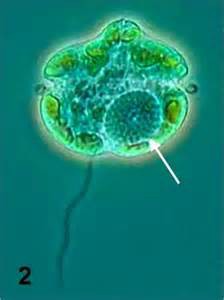
The dinoflagellate Karenia brevis.
Photo: Smithsonian Marine Station-Ft. Pierce FL
Several dinoflagellates produce toxins as a defense. Some generate what we call red tides. In the Gulf of Mexico, Karenia brevis is the species most responsible for red tide. Red tides typical form offshore and are blown into coastal areas via wind and currents. They are common off the coast of southwest Florida but occur occasionally in the panhandle. Many local red tides are actually formed in southwest Florida and pushed northward via currents. Red tides are known to kill marine mammals and fish, as well as closing areas for shellfish harvesting.
Like true plants, phytoplankton conduct photosynthesis. Between the diatoms and dinoflagellates, 50% of the planet’s oxygen is produced. These are truly important players in the ecology of both the open Gulf and local bays.
References
Annett, A.L., D.S. Carson, X. Crosta, A. Clarke, R.S. Ganeshram. 2010. Seasonal Progression of Diatom
Assemblages in Surface Waters of Ryder Bay, Antarctica. Polar Biology vol 33. Pp. 13-29.
Hasle, G.R., E.E. Syvertsen. 1997. Identifying Marine Phytoplankton. Academic Press Harcourt Brace and
Company. San Diego CA. edited by C.R. Tomas. Pp. 858.
Steidinger, K.A., K. Tangen. 1997. Identifying Marine Phytoplankton. Academic Press Harcourt Brace and
Company. San Diego CA. edited by C.R. Tomas. Pp. 858.
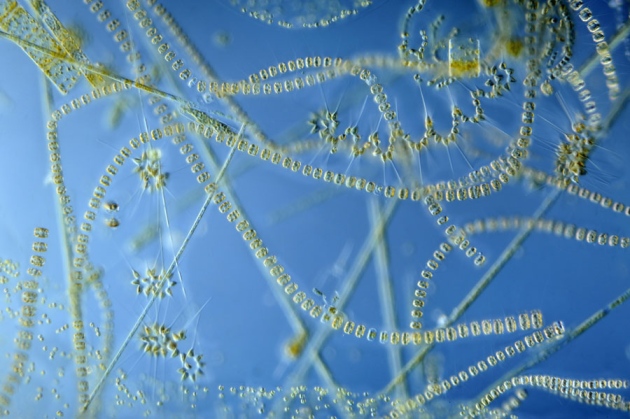
by Rick O'Connor | Jan 5, 2018
Last year I began a series of articles on the Gulf of Mexico. They focused on the physical Gulf – water, currents, and the ocean floor. This year the articles will focus on the life within the Gulf, and there is a lot of it.
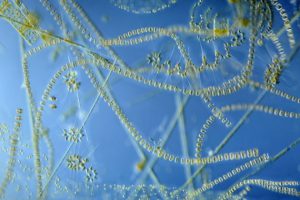
Single celled algae are the “grasses of the sea” and provide the base of most marine food chains.
Photo: University of New Hampshire
We will begin with the base of food web systems, the simplest creatures in the sea. The base of food systems are generally plants and the simplest of these are the single celled plants. Singled celled plants are a form of algae, not true plants in the sense we think of them, but serving the same role in the environment – which is the production of much needed energy.
What these single celled algae need to survive is the same as the more commonly known plants – sunlight, water, carbon dioxide, oxygen, and nutrients.
Sunlight is difficult for marine plants because sunlight only penetrates so deep. Therefore, marine plants and algae must live in shallow water, or have some mechanism to remain near the surface in the open sea. In relation to their overall body volume, smaller creatures have more surface area than larger ones. More surface area helps resist sinking and the smallest you can get is a single cell. Thus, most marine algae are single celled. Many single celled plants are encased in transparent shells that have spines and other adaptations to assist in increasing their surface area and keeping them near the surface. Some actually have drops of oil (buoyant in water) making it even easier to stay near the surface. These small floating algae drift in the surface currents, and drifting organisms are called plankton. Plankton that are “plant-like” are called phytoplankton.
The next needed resource is water; the Gulf and Bay are full of it. However, saltwater is not what they need – freshwater is, so they must desalinate the water before absorbing it. They can do this by adjusting the solutes within their cytoplasm. The greater the ratio of surface area is to volume, the more diffusion of solutes can take place – thus these small phytoplankton are very good at diffusing resources in (like water and carbon dioxide) and expelling waste (like ammonia and oxygen).
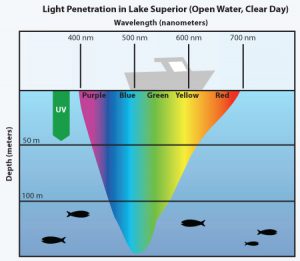
Image showing how deep different colors of light penetrates in the sea.
Image: Minnesota Sea Grant
Carbon dioxide and oxygen are dissolved in seawater and, like water, are diffused into the phytoplankton. Warmer water holds less oxygen so there would be a tendency to have more phytoplankton in colder waters. However, warmer waters are so because there is generally more sunlight, a needed resource. The colder, sunlit, surface waters off some coasts – such as California – have higher amounts of dissolved oxygen and are some of the most productive areas in the ocean. Phytoplankton can also serve as “carbon sinks” by removing carbon dioxide dissolved in the seawater coming from the atmosphere. However, this may not be the answer to excessive CO2 in the atmosphere because, like all creatures, you can only consume so much “food”. Excessive loads of carbon dioxide will not be consumed.
Finally, there is the need for nutrients. All plants need fertilizer. Nutrients in the sea come from either run-off from land, or decayed material from the ocean floor. Much of the nutrients are discharged into the Gulf by run-off from land. Because of this, much of the phytoplankton are congregated nearshore where rivers meet the sea. We think of marine life as equally distributed across the ocean, but in act it is not, there is more life nearshore. For the compost on the ocean floor to be of used by phytoplankton, it must reach the surface. This happens where a current called an upwelling occurs. Upwellings rise from the seafloor bringing with them the nutrients. Where upwellings occur, the seawater is colder, and sunlight abundant, you have the greatest concentration of marine life – all fueled by these phytoplankton.
In the Gulf, one of the most productive places is “the plume”, where the Mississippi River discharges. This massive river brings water, sediments, and nutrients, from most of the continent. The large plankton blooms attract massive schools of plankton consuming fish, predatory fish, sea birds, and marine mammals.
In the next post, we discuss some of the different phytoplankton that inhabit our coastal waters and the amazing things they do.
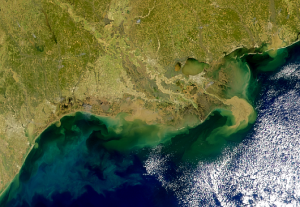
A satellite image showing the sediment plume of the Mississippi River. This plume brings with it nutrients that fuel plankton blooms.
Image: NASA satellite
References
Kirst G.O. (1996) Osmotic Adjustment in Phytoplankton and MacroAlgae. In: Kiene R.P., Visscher P.T.,
Keller M.D., Kirst G.O. (eds) Biological and Environmental Chemistry of DMSP and Related Sulfonium Compounds. Springer, Boston, MA







